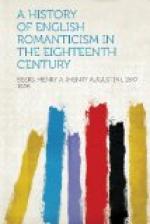[3] Cf. The Tannhaeuser legend and the Venusberg.
[4] “The Wife of Usher’s Well.”
[5] It should never be forgotten that the ballad (derived from ballare—to dance) was originally not a written poem, but a song and dance. Many of the old tunes are preserved. A number are given in Chappell’s “Popular Music of the Olden Time,” and in the appendix to Motherwell’s “Minstrelsy, Ancient and Modern” (1827).
[6] “A Ballad.” One theory explains these meaningless refrains as remembered fragments of older ballads.
[7] Reproduced by Rossetti and other moderns. See them parodied in Robert Buchanan’s “Fleshly School of Poets”:
“When seas do roar and
skies do pour,
Hard is the lot of the sailor
Who scarcely, as he reels,
can tell
The sidelights from the binnacle.”
[8] “I never heard the old song of Percie and Douglas that I found not my heart moved more than with a trumpet; and yet it is sung but by some blind crouder, with no rougher voice than rude style; which being so evil apparelled in the dust and cobwebs of that uncivil age, what would it work, trimmed in the gorgeous eloquence of Pindar!”
[9] Empty: “Bonnie George Campbell.”
[10] “Lord Randall.”
[11] Turf: “The Twa Corbies.”
[12] I use this phrase without any polemic purpose. The question of origins is not here under discussion. Of course at some stage in the history of any ballad the poet, the individual artist, is present, though the precise ration of his agency to the communal element in the work is obscure. For an acute and learned view of this topic, see the Introduction to “Old English Ballads,” by Professor Francis B. Gummere (Atheneum Press Series), Boston, 1894.
[13] From “Jock o’ Hazel Green.” “Young Lochinvar” is derived from “Katherine Janfarie” in the “Minstrelsy of the Scottish Border.”
[14] “Scott has given us nothing more complete and lovely than this little song, which unites simplicity and dramatic power to a wildwood music of the rarest quality. No moral is drawn, far less any conscious analysis of feeling attempted: the pathetic meaning is left to be suggested by the mere presentment of the situation. Inexperienced critics have often named this, which may be called the Homeric manner, superficial from its apparent simple facility.”—Palgrave: “Golden Treasury" (Edition of 1866), p. 392.
[15] “Brown Robyn’s Confession.” Robin Hood risks his life to take the sacrament. “Robin Hood and the Monk.”
[16] “Sir Hugh.” Cf. Chaucer’s “Prioresse Tale.”
[17] “The Gay Goshawk.”
[18] “Johnnie Cock.”
[19] “Young Hunting.”
[20] “The Twa Sisters.”
[21] “The Wife of Usher’s Well.”
[22] “Fair Margaret and Sweet William.”
[23] “Sweet William’s Ghost.”
[24] “Clerk Colven.”




